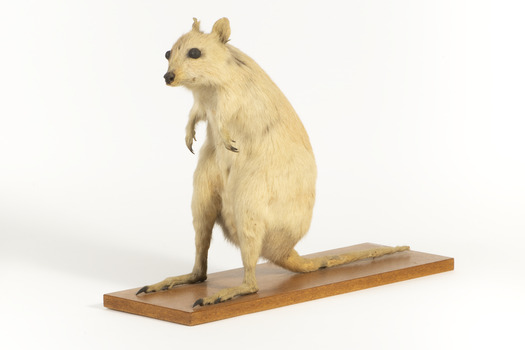Historical information
A rufous bettong is about the size of a rabbit, with body length ranging from 30cm to 38cm among species. All bettongs have long tails, roughly equal to body length. Body weight ranges from 1.2 kg in the smallest species (Northern Bettong) to 2.8kg in the Rufous Bettong, the largest of the group. Males tend to be slightly larger than females. Bettongs have furry coats, ranging in colour from grey to ginger and brown. The bettong is endemic to Australia, and is an important part of Australia's Indigenous biodiversity. There are five living species of bettong; Eastern Bettong, Burrowing Bettong, Brush-tailed Bettong, Northern Bettong, Rufous Bettong. The bettong is a member of the Potoroidae family along with the endangered Potoroos, and the extinct Desert Rat-Kangaroos.
This specimen is part of a collection of almost 200 animal specimens that were originally acquired as skins from either the Trustees of the Australian Museum or from the amateur anthropologist Reynell Eveleigh Johns between 1860-1880 and mounted by members of the Burke Museum Committee around the same time. When all Taxidermy mounts were completed, they were quickly put-on display in the formal space of the Museum’s original exhibition hall where they continue to be on display. This display of taxidermy mounts initially served to instruct visitors to the Burke Museum of the natural world around them, today it serves as an insight into the collecting habits of the 19th century.
Significance
This specimen is part of a significant and rare taxidermy mount collection in the Burke Museum. This collection is scientifically and culturally important for reminding us of how science continues to shape our understanding of the modern world. They demonstrate a capacity to hold evidence of how Australia’s fauna history existed in the past and are potentially important for future environmental research.
This collection continues to be on display in the Museum and has become a key part to interpreting the collecting habits of the 19th century.
Physical description
Average sized rufous bettong with large clawed hind legs, small clawed fore legs, and a long tail that is roughly the length of its body and covered lightly in fur. The pelage of the bettong is fine and soft with the body fur cream and pale ochre in colouring with specks of brown while the underbelly is a solid cream colour. The head is small with a short muzzle and two small rounded ears, and features two round dark brown eyes made from clay.
Inscriptions & markings
On mounting board:
BMM5893/
Subjects
References
- Bettongs - Bush Heritage
- Bettongia - Animalia
- Menkhorst, P., Rogers, D., Clarke, R., Davies, J., Marsack, P. & Franklin, K. 2019, The Australian Bird Guide, CSIRO Publishing, Clayton, Victoria.




















